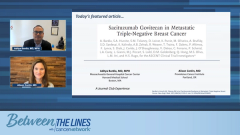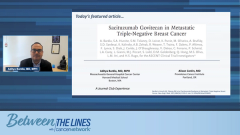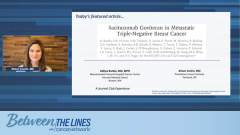
Sacituzumab Govitecan in mTNBC: Results From the ASCENT Study
Centering discussion on sacituzumab govitecan use in metastatic triple-negative breast cancer, expert oncologists reflect on results from the phase 3 ASCENT study.
Episodes in this series

Transcript:
Aditya Bardia, MD, MPH: That’s a good segue. Let me review the ASCENT trial briefly: the design, the baseline characteristics, the clinical outcomes. We’ll continue the discussion in terms of what it means for the field and next steps. The ASCENT trial was a global phase 3 randomized clinical trial of patients with metastatic TNBC who had received prior lines of therapy. At least 1 line of taxane was required in the ASCENT trial. More than 500 patients were randomized to receive sacituzumab govitecan or physician’s choice of treatment, which would include eribulin, capecitabine, gemcitabine, or vinorelbine. These are the standard agents we would have utilized in this setting. [The trial] compared this novel first-in-class ADC [antibody-drug conjugate] targeted toward TROP2 vs standard-of-care chemotherapy. The primary end point was progression-free survival, and a key secondary end point was overall survival.
In terms of baseline characteristics, those were well balanced between the 2 arms. The median age was 54 years old with sacituzumab govitecan and 53 years old with standard chemotherapy. That’s a competitively younger age, which is to be expected given that this trial was for patients with metastatic TNBC. There was a good performance status. About 8% of patients in this clinical trial had germline BRCA mutation. The majority of patients had TNBC at primary diagnosis, but they were a subset. One-third of patients who had this switch where tumors were originally ER [estrogen receptor]–positive, but in the metastatic setting they became TNBC and were therefore eligible for the clinical trial.
In terms of the sites of disease, patients predominantly had visceral metastases, which is to be expected for a trial. In this setting, patients had received more than 2 lines of prior therapy, which included anthracyclines, platinums, capecitabine, and taxanes. This is a typical patient population we would see in clinical practice in the TNBC setting.
In terms of clinical outcomes, this table summarizes the treatment efficacy. Overall, patients who receive sacituzumab govitecan had an improvement in progression-free survival and overall survival. The median progression-free survival was 5.6 months with sacituzumab govitecan vs 1.7 months with standard chemotherapy corresponding to a hazard ratio of 0.41, which is close to doubling of progression-free survival. Similarly, there was doubling of overall survival. Overall survival was 12 months with sacituzumab govitecan vs about 6 months with standard chemotherapy, corresponding to a hazard ratio of 0.48. The response rate with standard chemotherapy was 5% vs 35% with sacituzumab govitecan. From different angles, you can clearly see that sacituzumab govitecan was superior to standard chemotherapy. That’s why this was a practice-changing study.
In terms of time to response, this is important in the metastatic TNBC setting because these tumors have an aggressive tumor biology. The median time to response was 1.5. Usually, at the time of first restating scans, you could see your response. There was a range of 0.7 to 10.6. Sometimes you can have late responses.
When we talk about any drug, we must talk about efficacy as well as adverse effects. In terms of the adverse effect profile of sacituzumab govitecan, the drug has SN38 as the payload, which is the active metabolite of irinotecan. The adverse effect profile is like that of irinotecan myelosuppression with neutropenia anemia and GI [gastrointestinal] toxicity, with diarrhea and nausea being the common adverse effects. The incidence of adverse effects, particularly diarrhea, is much lower than what we see with irinotecan. For example, grade 3 diarrhea is 10% with sacituzumab govitecan; with irinotecan, it’s around 30%. That’s the advantage of the ADC, that you can have better efficacy and lower toxicity compared with the parent chemotherapy compound. The final adverse effect seen with sacituzumab govitecan is alopecia. It’s important to discuss that with patients.
Adverse effects not seen with sacituzumab govitecan include pneumonitis, cardiac toxicity, and peripheral neuropathy. Overall, the majority of patients were able to remain on sacituzumab govitecan with dose reductions or treatment hold. Usually, these are adverse effects that oncologists are familiar with—myelosuppression, GI toxicity—and they can respond with appropriate supportive therapy, and the use of G-CSF [granulocyte colony-stimulating factor] or antidiarrheals if needed.
Transcript edited for clarity.
Newsletter
Stay up to date on recent advances in the multidisciplinary approach to cancer.





















































































